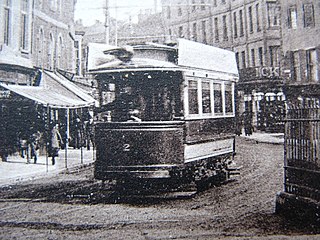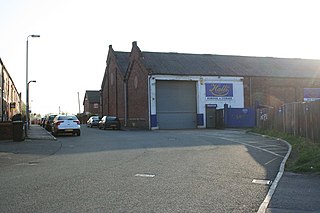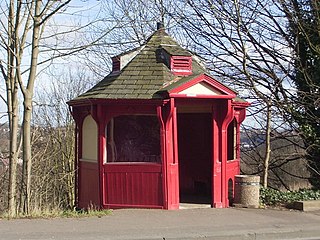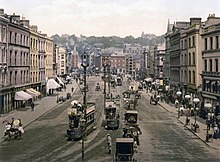
Hong Kong Tramways (HKT) is a 3 ft 6 in narrow-gauge tram system in Hong Kong. Owned and operated by RATP Dev Transdev Asia, the tramway runs on Hong Kong Island between Kennedy Town and Shau Kei Wan, with a branch circulating through Happy Valley.
Brush Traction is a manufacturer and maintainer of railway locomotives in Loughborough, England. It is a subsidiary of Wabtec.

The National Tramway Museum is a tram museum located at Crich, Derbyshire, England. The museum contains over 60 trams built between 1873 and 1982 and is set within a recreated period village containing a working pub, cafe, old-style sweetshop and tram depots. The museum's collection of trams runs through the village-setting with visitors transported out into the local countryside and back. The museum is operated by the Tramway Museum Society, a registered charity.

The Blackpool Tramway runs from Blackpool to Fleetwood on the Fylde Coast in Lancashire, England. The line dates back to 1885 and is one of the oldest electric tramways in the world. It is operated by Blackpool Transport Services (BTS) and runs for 18 km. It carried 4.8 million passengers in 2019/20.

The Cork, Blackrock and Passage Railway known locally to the locals as The Black Bridge (CB&PR) was a 3 ft narrow gauge railway in County Cork, Ireland. The line originally opened in 1850 as a 5 ft 3 in Irish standard gauge railway between Cork and Passage West and operated steam feeder ferries to other locations round Cork Harbour. The company was heavily dependent on summer tourist traffic for a considerable proportion of its revenue. The railway was converted to 3 ft narrow gauge in 1900 in conjunction with extensions southwards to Crosshaven which were completed in 1904. The railway closed in 1932 and has since been replaced by a public pathway and nature area.
The Cork City Railways were constructed in 1911 and opened in 1912 to connect the Irish standard gauge systems north and south of the River Lee in Cork, Ireland.

The Taunton Tramway was an electric street tramway in Taunton, the county town of Somerset, England. It operated a fleet of six narrow gauge tramcars on a single route of 1.66 miles (2.67 km) between 1901 and 1921 when the tramway closed due to a dispute over the cost of electricity.
The South Lancashire trolleybus system once served towns in South Lancashire, England, including Atherton, Bolton, Swinton and Leigh and St Helens. Opened on 3 August 1930, it replaced the South Lancashire Tramways network.

Torquay Tramways operated electric street trams in Torquay, Devon, England, from 1907. They were initially powered by the unusual Dolter stud-contact electrification, but in 1911 was converted to more conventional overhead-line supply. The line was extended into neighbouring Paignton in 1911 but the whole network was closed in 1934.

Cardiff Corporation Tramways was a company that operated an electric tramway service in Cardiff between 1902 and 1950.

Burnley Corporation Tramways operated a tramway service in Burnley between 1901 and 1935.

Dundee and District Tramways operated a tramway service in Dundee between 1877 and 1899.

Wigan Corporation Tramways operated a tramway service in Wigan, England, between 1901 and 1931. The first tramway service in the town was run by the Wigan Tramways Company, whose horse trams began carrying passengers in 1880. They began replacing horses with steam tram locomotives from 1882, but the company failed in 1890 when a Receiver was appointed to manage it. The Wigan & District Tramways Company took over the system in 1893 and ran it until 1902. Meanwhile, Wigan Corporation were planning their own tramway system, obtaining an authorising Act of Parliament in 1893, and a second one in 1898. This enabled them to build electric tramways, and in 1902, they took over the lines of the Wigan & District Tramways Company.
Llanelly and District Electric Tramways operated a standard gauge tramway service in Llanelli, Wales, between 1908 and 1933. It was the successor to a 3 ft gauge horse tramway, which ran from 1882 until 1908. A complex series of negotiations took place in the early 1900s, resulting in the horse tramway being converted to an electric tramway. Standard gauge horse trams were run initially, until the company completed North Dock power station, which supplied electricity to the tramway. Two of the employees who worked on the construction went on to found Balfour Beatty.
Halifax Corporation Tramways operated a tramway service in Halifax, West Yorkshire, England between 1898 and 1939. After considering lifts and inclined planes to assist trams in negotiating the steep hills to the south of the town, they obtained permission to build a conventional system in 1897, and the first three routes opened in 1898. By 1905 there were 37 miles (60 km) of track and 96 tramcars, supplied by two manufacturers. In 1921, an additional route was added to the system, and the Corporation embarked on a programme of building their own tramcars, some of which replaced existing vehicles, while some extended the fleet. During the 1930s, the trams were gradually replaced by motor buses, either run by the Corporation or by private companies, and the last tram ran on 14 February 1939.

Huddersfield Corporation Tramways operated a tramway service in Huddersfield, England, between 1883 and 1940. It initially used steam locomotives pulling unpowered tramcars, but as the system was expanded, a decision was taken to change to electric traction in 1900, and the first electric trams began operating in February 1901. The system was built to the unusual gauge of 4 ft 7+3⁄4 in, in the hope that coal wagon from neighbouring coal tramways, which used that gauge, could be moved around the system. This did not occur, but two coal trams were used to delivered coal to three mills.

The Perugia Tramway opened in 1899, which was the same year as that in which electric street lighting came to the city. The purpose of the Tramway was to link the historical city centre with the city's railway station, some 3 km away down the hill.
Bradford Corporation Tramways were a tramway network in the city of Bradford, West Riding of Yorkshire, England which operated trams from 1882 until 1950 and trolleybuses from 1911 until 1972. The track gauge of the tramways was 4 ft.
Trams existed in Sri Lanka's capital Colombo from 1899 to 1960.
County Cork has a number of rail-trails and greenways and, as of 2022, there are plans and proposals at various stages of preparation to create a network of walking trails for the county. The term "Cork Greenway" has been used in press coverage, but is not yet used officially.
















